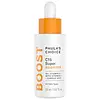What's inside
What's inside
 Key Ingredients
Key Ingredients

 Benefits
Benefits

 Concerns
Concerns

No concerns
 Ingredients Side-by-side
Ingredients Side-by-side

Water
Skin ConditioningGlycerin
HumectantPanthenol
Skin ConditioningAscorbyl Tetraisopalmitate
AntioxidantTocopheryl Acetate
AntioxidantLecithin
EmollientOryza Sativa Bran Oil
EmollientPhenoxyethanol
PreservativeCitrus Aurantium Dulcis Peel Oil
MaskingPullulan
Citrus Reticulata Peel Oil
MaskingEpilobium Angustifolium Flower/Leaf/Stem Extract
Skin ConditioningNannochloropsis Oculata Extract
HumectantPalmitoyl Tripeptide-5
Skin ConditioningTerminalia Ferdinandiana Fruit Extract
AntioxidantBackhousia Citriodora Leaf Extract
AstringentCodonopsis Lanceolata Extract
AntioxidantCitrus Glauca Fruit Extract
HumectantDavidsonia Jerseyana Fruit Extract
AntioxidantDipeptide Diaminobutyroyl Benzylamide Diacetate
Skin ConditioningCitrus Aurantium Amara Leaf/Twig Oil
MaskingLactic Acid
BufferingXanthan Gum
EmulsifyingSclerotium Gum
Emulsion StabilisingPotassium Sorbate
PreservativeSodium Stearoyl Glutamate
CleansingTetrasodium EDTA
Ethylhexylglycerin
Skin ConditioningBenzoic Acid
MaskingSorbic Acid
PreservativeSodium Metabisulfite
AntioxidantWater, Glycerin, Panthenol, Ascorbyl Tetraisopalmitate, Tocopheryl Acetate, Lecithin, Oryza Sativa Bran Oil, Phenoxyethanol, Citrus Aurantium Dulcis Peel Oil, Pullulan, Citrus Reticulata Peel Oil, Epilobium Angustifolium Flower/Leaf/Stem Extract, Nannochloropsis Oculata Extract, Palmitoyl Tripeptide-5, Terminalia Ferdinandiana Fruit Extract, Backhousia Citriodora Leaf Extract, Codonopsis Lanceolata Extract, Citrus Glauca Fruit Extract, Davidsonia Jerseyana Fruit Extract, Dipeptide Diaminobutyroyl Benzylamide Diacetate, Citrus Aurantium Amara Leaf/Twig Oil, Lactic Acid, Xanthan Gum, Sclerotium Gum, Potassium Sorbate, Sodium Stearoyl Glutamate, Tetrasodium EDTA, Ethylhexylglycerin, Benzoic Acid, Sorbic Acid, Sodium Metabisulfite
Water
Skin ConditioningAscorbic Acid
AntioxidantGlycerin
HumectantEthoxydiglycol
HumectantPPG-26-Buteth-26
Skin ConditioningMannitol
HumectantTridecapeptide-1
Skin ConditioningPalmitoyl Tripeptide-5
Skin ConditioningErgothioneine
AntioxidantSodium Hyaluronate
HumectantPentylene Glycol
Skin ConditioningPEG-40 Hydrogenated Castor Oil
EmulsifyingBisabolol
MaskingSodium Gluconate
Skin ConditioningDecylene Glycol
Skin ConditioningFerulic Acid
AntimicrobialOryza Sativa Bran Extract
Skin ConditioningTocopherol
AntioxidantPolyacrylate Crosspolymer-6
Emulsion Stabilising1,2-Hexanediol
Skin ConditioningPanthenol
Skin ConditioningSodium Phytate
Sodium Hydroxide
BufferingCitric Acid
BufferingPhenoxyethanol
PreservativeWater, Ascorbic Acid, Glycerin, Ethoxydiglycol, PPG-26-Buteth-26, Mannitol, Tridecapeptide-1, Palmitoyl Tripeptide-5, Ergothioneine, Sodium Hyaluronate, Pentylene Glycol, PEG-40 Hydrogenated Castor Oil, Bisabolol, Sodium Gluconate, Decylene Glycol, Ferulic Acid, Oryza Sativa Bran Extract, Tocopherol, Polyacrylate Crosspolymer-6, 1,2-Hexanediol, Panthenol, Sodium Phytate, Sodium Hydroxide, Citric Acid, Phenoxyethanol
 Reviews
Reviews

Ingredients Explained
These ingredients are found in both products.
Ingredients higher up in an ingredient list are typically present in a larger amount.
Glycerin is already naturally found in your skin. It helps moisturize and protect your skin.
A study from 2016 found glycerin to be more effective as a humectant than AHAs and hyaluronic acid.
As a humectant, it helps the skin stay hydrated by pulling moisture to your skin. The low molecular weight of glycerin allows it to pull moisture into the deeper layers of your skin.
Hydrated skin improves your skin barrier; Your skin barrier helps protect against irritants and bacteria.
Glycerin has also been found to have antimicrobial and antiviral properties. Due to these properties, glycerin is often used in wound and burn treatments.
In cosmetics, glycerin is usually derived from plants such as soybean or palm. However, it can also be sourced from animals, such as tallow or animal fat.
This ingredient is organic, colorless, odorless, and non-toxic.
Glycerin is the name for this ingredient in American English. British English uses Glycerol/Glycerine.
Learn more about GlycerinThis synthetic peptide is created from lysine, valine, and palmitic acid.
According to the manufacturer, in-vitro studies show tissue growth and collagen synthesis. Another in-vivo study found 60 volunteers saw a significant reduction in wrinkles after 84 days.
Due to its palmitic acid base, this peptide may not be fungal-acne safe.
Learn more about Palmitoyl Tripeptide-5Panthenol is a common ingredient that helps hydrate and soothe the skin. It is found naturally in our skin and hair.
There are two forms of panthenol: D and L.
D-panthenol is also known as dexpanthenol. Most cosmetics use dexpanthenol or a mixture of D and L-panthenol.
Panthenol is famous due to its ability to go deeper into the skin's layers. Using this ingredient has numerous pros (and no cons):
Like hyaluronic acid, panthenol is a humectant. Humectants are able to bind and hold large amounts of water to keep skin hydrated.
This ingredient works well for wound healing. It works by increasing tissue in the wound and helps close open wounds.
Once oxidized, panthenol converts to pantothenic acid. Panthothenic acid is found in all living cells.
This ingredient is also referred to as pro-vitamin B5.
Learn more about PanthenolPhenoxyethanol is a preservative that has germicide, antimicrobial, and aromatic properties. Studies show that phenoxyethanol can prevent microbial growth. By itself, it has a scent that is similar to that of a rose.
It's often used in formulations along with Caprylyl Glycol to preserve the shelf life of products.
Water. It's the most common cosmetic ingredient of all. You'll usually see it at the top of ingredient lists, meaning that it makes up the largest part of the product.
So why is it so popular? Water most often acts as a solvent - this means that it helps dissolve other ingredients into the formulation.
You'll also recognize water as that liquid we all need to stay alive. If you see this, drink a glass of water. Stay hydrated!
Learn more about Water